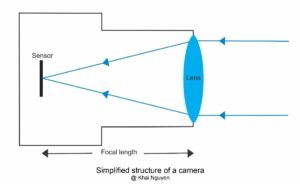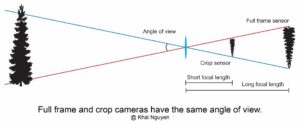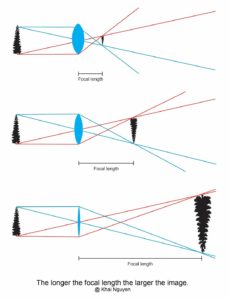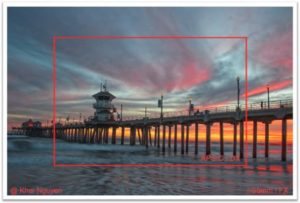Khai Nguyen, EPSA, SPSA
Many photographers misunderstand that the focal length of a lens mounted on a crop camera would effectively be extended by a crop factor. For this reason, they think they can reach subjects at a further distance and make the images larger. This article will disprove this myth once and for all.
Background review
Before getting into details, we need to go over some basic facts about cameras and lenses. There are two kinds of cameras: full-frame and crop cameras. Full-frame cameras are those with an image sensor equivalent to 35mm film. The sensor size is 36mm x 24mm, and its diagonal is 43.27mm. Crop cameras are those with sensors smaller than 36mm x 24mm. The most popular crop camera has a sensor size of 24mm x 16mm, and its diagonal is 28.44mm. The crop factor is the ratio of the full-frame sensor diagonal to the crop sensor diagonal. The crop factor in this case is 1.52.
Nikon often refers to its full-frame cameras as “FX” and its crop cameras with the 24mm x 16mm sensor as “DX.” Canon and other manufacturers refer to their full-frame and crop cameras as “35mm” and “APS-C” (Advanced Photo System Type C), respectively.

Equivalent focal length
Each lens has a true focal length and angle of view regardless of the camera and its sensor. When a lens is used with a camera, the view it can see may change. For example, a Nikon lens 24mm F/1.4G has an angle of view of 84º on a full-frame FX and 61º on a DX. In order to have the same angle of view of 84º, a wider lens of 16mm is needed on the DX. Therefore, some manufacturers have often claimed that a 16mm lens has an angle of view equivalent to a 24mm lens on an FX. Similarly, a 400mm lens on a DX/APS-C camera has an angle of view equivalent to a 600mm lens on a FX/35mm camera.
The manufacturers’ definitional claim simply means that two lenses with different focal lengths may have the same angle of view. Many photographers interpret incorrectly that a short lens on a crop camera has a focal length equivalent to a long lens on a full-frame camera. The equivalent focal length is the true focal length multiplied by the crop factor. They presume that the focal length of a lens mounted on a DX/APS-C, for example, would effectively be extended 1.5 times. Repetition does make a false statement true for some people. This conspicuous myth causes many photographers to buy crop cameras, which are cheaper than full-frame cameras, to shoot wildlife and sports with short lenses since long lenses are quite expensive .

Optical fact 1: The longer the lens, the larger the image
The length of a lens is called focal length. This is the distance between the center of the lens and its focal point, where initially collimated rays of light meet after passing through a convex lens or reflecting from a concave mirror in order to form sharp images. Camera sensors are placed right at the lens focal point inside the camera. The longer the focal length, the larger the image, while other factors remain unchanged.
Physical science has proved that among those convex lenses with the same diameter (i.e., same height), the thinner the lens, the longer the focal length, and as a result, the larger the image. It has also proved that among those lenses with the same focal length, creating images of the same size, the larger the diameter, the larger the aperture, the more light coming through the lens, and therefore, the brighter the image. The aperture is the ratio of focal length to lens diameter. Each lens also has a shutter, which changes the diameter of the lens opening. Therefore, even a prime lens with fixed focal length has different apertures. Thus, a 400mm lens with a lens opening diameter of 71.4mm has a maximum aperture of F/5.6.
Aperture = Focal Length / Lens Diameter
The ratio of the image size on the sensor to the size of the subject is called the magnification ratio, which depends on physical focal length and has nothing to do with equivalent focal length. Images are often smaller than actual subjects. In these cases, the magnification ratio is less than 1. Only macro lenses have the capability to create images equal to or bigger than actual subjects. This means that the magnification ratio is greater than 1.

In reality, a camera lens is composed of several optical elements instead of one single lens. However, the optical effects are the same .
Optical fact 2: The bigger the camera sensor, the larger the image
All full-frame cameras have a 36mm x 24mm image sensor. Crop cameras have smaller image sensors. Consequently, images created by crop cameras are smaller than 36mm x 24mm. When both cameras have the same angle of view as shown in the picture above, a crop camera must use a wider (i.e., shorter) lens. In this case, people can correctly say that a short lens on the crop camera has the same angle of view as the long lens on the full-frame camera. But it is not correct to say that the short lens has the same focal length as the long lens.
As a matter of fact, a short focal length on a crop camera cannot be extended, and its image cannot be as large as full-frame image since the magnification ratio, an optical phenomenon, only depends on physical focal length. This has nothing to do with equivalent focal length or crop factor. These are fancy terms unnecessarily created by the camera industry.

If crop cameras can have the same magnification power as full-frame cameras when both have same angle of view, then why would camera manufacturers keep producing both crop and full-frame cameras? The answer is that a crop sensor is less expensive. They have to make crop cameras to accommodate those buyers who cannot afford full-frame cameras and long lenses.
Optical fact 3: A large sensor usually has a higher resolution
Full-frame FX/35mm sensors have a diagonal that is one-and-a-half times longer than that of a DX/APS-C sensor. However, their area is 2.3 times larger than that of DX/APS-C sensors. If both have the same pixel density, full-frame sensors will have a higher resolution and produce larger and sharper images, all other things being equal. The image sensor is the soul of a digital camera. Again, this issue has nothing to do with equivalent focal length.

Conclusion
Three optical facts have revealed the truth about the equivalent focal length and crop factor. They have clearly demystified the equivalent focal length myth. If you can afford it, buy a full-frame camera. If you are in love with wildlife or sport photography, buy a long lens.
When Nikon entered the digital camera market in 1999, it introduced its first digital camera D-1 with a 23.7mm x 15.6mm sensor, equal to 2/3 of a full-frame sensor, and a resolution of 2.7 megapixels at a price of $5,850. Nikon produced its first full-frame camera D-3 with a 36mm x 24mm sensor and a resolution of 12.1 megapixels at a price of $4,999 in 2007. Canon had its first crop camera EOS D30 with 3.1 megapixels in 2000 and its first full-frame EOS 1Ds with 11 megapixels in 2011 at the price of $8,000. The history tells us that sensor cost was the key factor for delaying the production of the full-frame camera.
With the advancement of technology, the production of camera sensors will be easier and cheaper, and I believe that crop cameras will disappear in the near future. Even full-frame sensors will become antique products soon, since some camera manufacturers have already produced 50MP or 100MP digital cameras with extra-large sensors of 44mm x 33mm or 53.7mm x 40.4mm.
- Article first published in the Photographic Society of America (PSA) Journal